The ASUS ROG Phone III Review: A 144Hz 6000mAh Beast With Caveats
by Andrei Frumusanu on August 28, 2020 9:00 AM EST- Posted in
- Mobile
- Smartphones
- Snapdragon 865
- ROG Phone III
System Performance
System performance of the ROG Phone III should be interesting given its gaming phone nature, as well as for the fact that it’s the first Snapdragon 865+ device we’ve come to test. As always, system performance doesn’t necessarily just depend on the hardware of a device, but also on the software tuning that a vendor does to its DVFS and SoC scheduler settings.
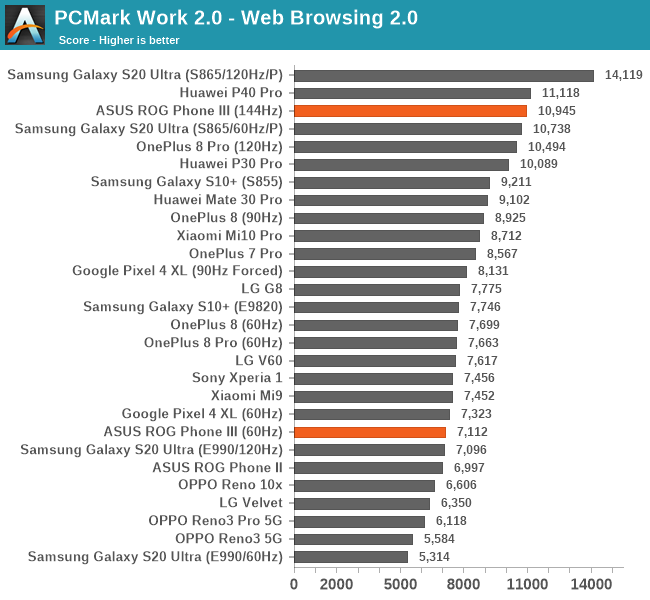
In the PCMark web-browsing test, the workload is quite sensible to scheduler and DVFS settings. Here the ROG Phone III is rather conservatively tuned in its 60Hz setting, only catching up due to the higher 144Hz refresh rate when in that mode.
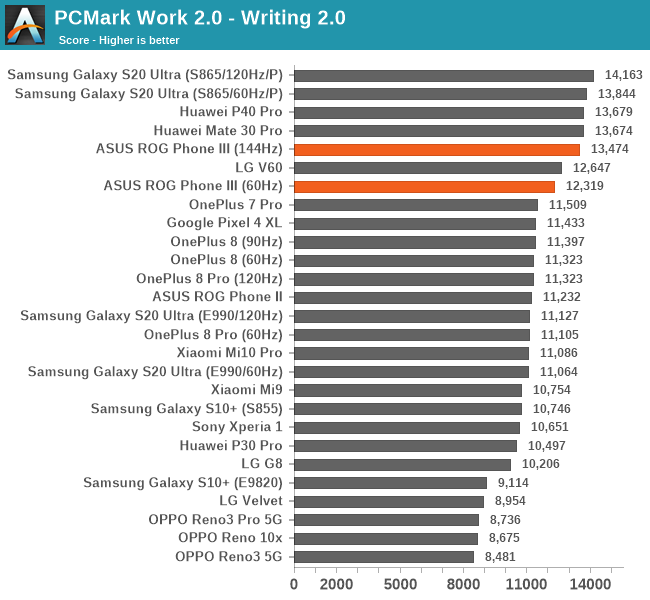
The writing sub-test is the most important of PCMark, and the ROG3 here fares slightly better than most other Snapdragon 865 devices on the market, but falls just short of Kirin 990 phones as well as the Snapdragon Galaxy S20.
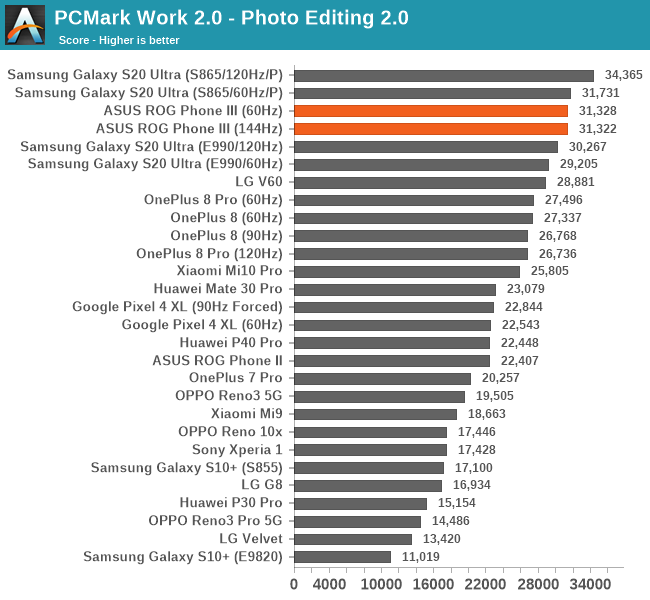
We see a similar positioning for the photo editing test.
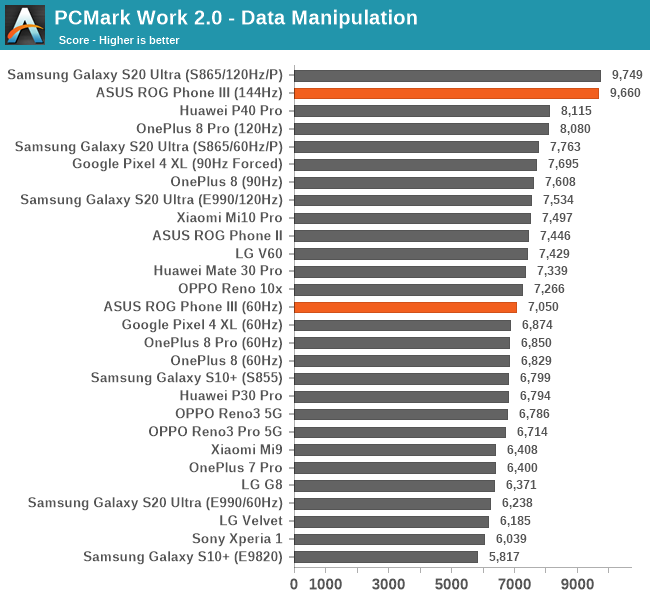
The data-manipulation test seems refresh-rate bottlenecked and here the ROG3 sees a big jump when scaling from 60 to 144Hz.
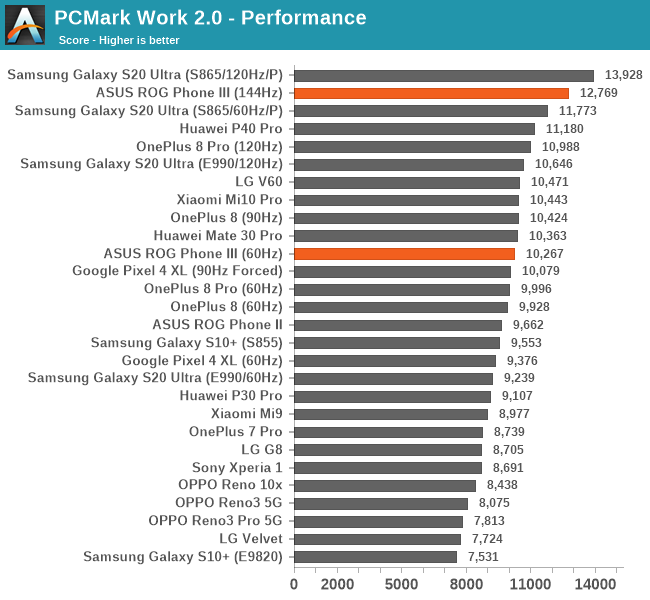
Overall, in the PCMark performance scores, the ROG Phone III only falls short to the Snapdragon Galaxy S20 Ultra in our tests. There are a few details I want to expand in regards to this positioning and why it doesn’t fare better:
The test scores here were performed under the phone’s default operating conditions, with X-Mode being disabled. Unfortunately, it seems that under these conditions, the phone’s performance is very conservative and doesn’t really stand out much from the crowd.
The scores are significantly improved when enabling X-Mode, however I take issue in publishing these figures into our charts given that what this mode does is simply cripple normal DVFS operation of the SoC by raising the minimum operating frequencies, or essentially just pegging them to their maximum.
There’s been a delicate balance by various vendor’s performance modes, some which implement quite reasonable settings, whilst other simply are akin to just enabling a benchmark cheat mode. Samsung’s and Huawei’s performance modes are still reasonable as they still use the full dynamic range operating frequencies of the SoC, only increasing the aggressiveness of the scaling behaviour.
Other vendors such as OPPO, and ASUS here, just enable a rather dumb “all-out” mode that in my view isn’t very realistic for a battery powered device, and that I wouldn’t recommend anyone on actually using. I’ll get into more detail about this in the GPU performance section, but I don’t find the default X-Mode levels particularly well implemented when it comes to the balance between performance and power consumption.
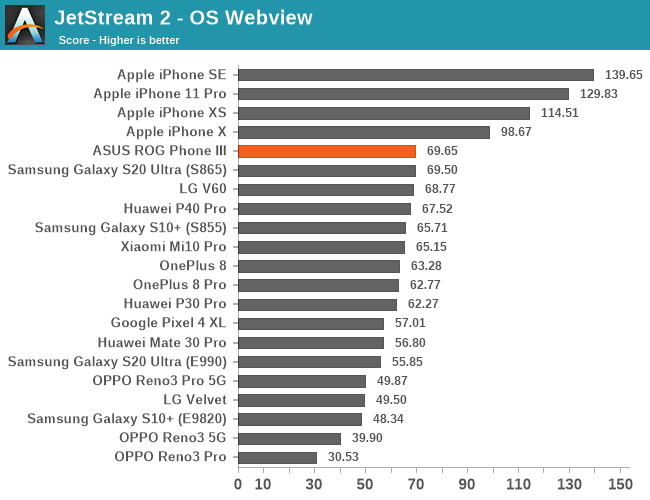

The ROG Phone III did adequately in the browser Javascript benchmarks, although WebXPRT 3 does showcase its rather conservative performance tuning when in its default operating mode.
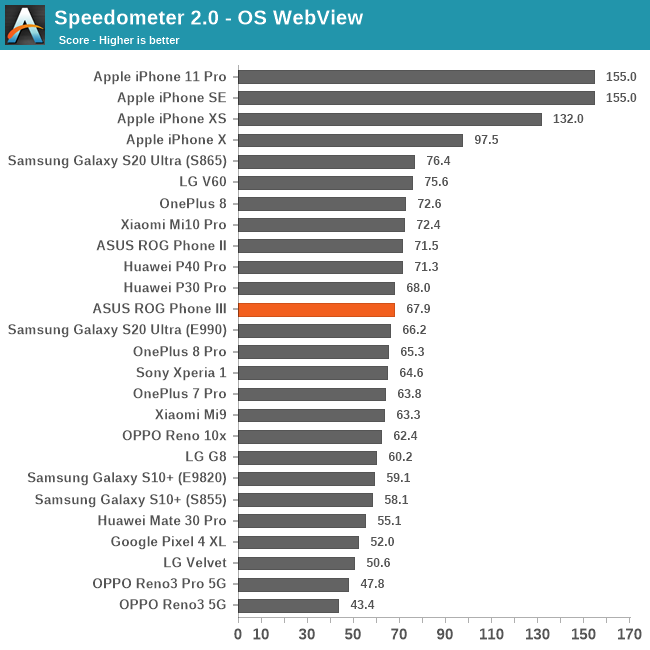
I had some really odd issues with Speedometer 2.0, in that the ROG Phone III kept performing quite horribly in WebView containers as well as Chrome. I’m not sure what happened here, as the same versions of the apps performed quite well on other Snapdragon 865 devices, which points out to possibly some OS-specific issue on the ASUS device. Using Samsung Internet for example made it perform normally – really odd.
Update: The issue has been resolved with the latest firmware update.
Overall, system performance of the ROG Phone III is excellent, but generally I wouldn’t say that it’s in any way class-leading or able to distinguish itself from other 120Hz phones. The 144Hz mode isn’t something that you will notice over other 120Hz phones, and whilst the phone is very snappy, without the questionable every-day use of X-Mode, it lags behind Samsung’s devices. In this regard, the ROG3 doesn’t perform much differently to any other high-refresh rate Snapdragon 865 phones.


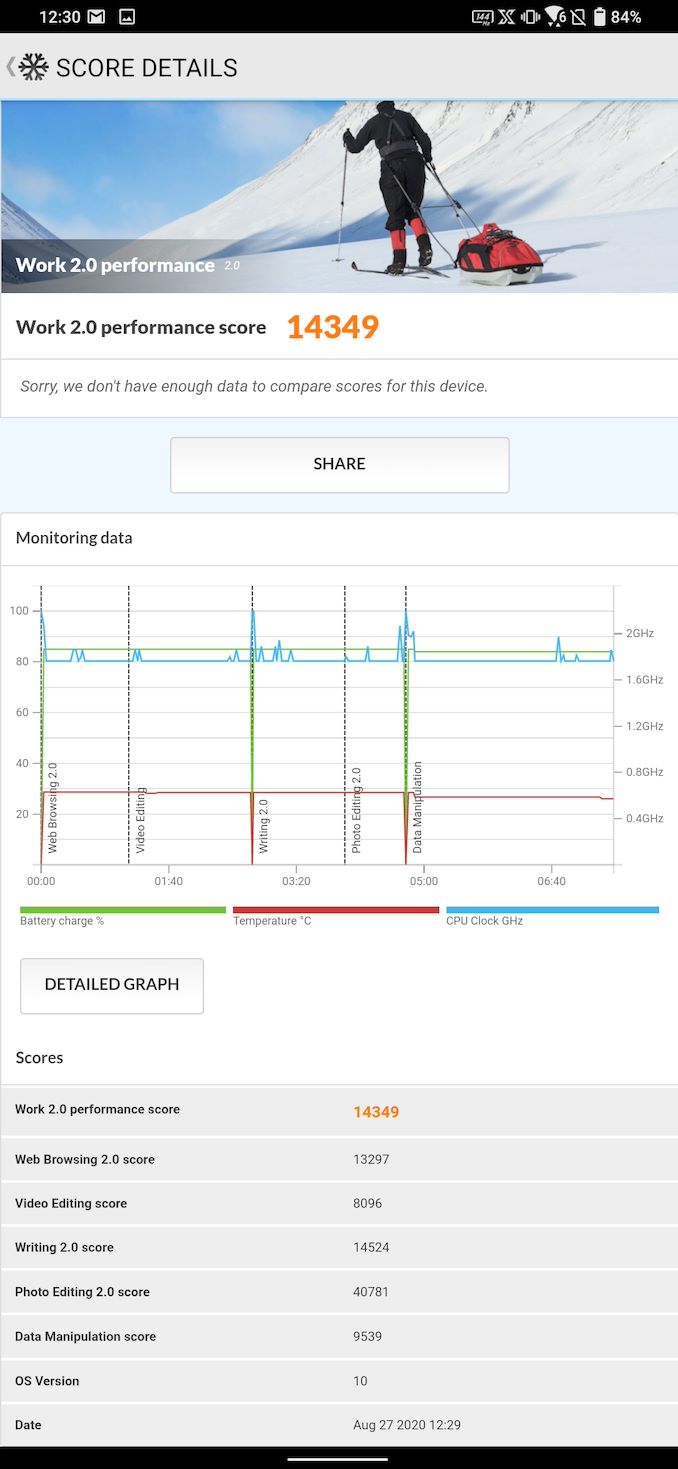








71 Comments
View All Comments
Kishoreshack - Friday, August 28, 2020 - link
Just love how far ASUS has come with its phonesKangal - Sunday, August 30, 2020 - link
Yeah, in 2019... but this year they have gotten worse.Just compare the Zenfone 6 to the Zenfone 7 for starters.
On the ROG 2 vs ROG 3,
The new device is slightly larger, heavier, and lost the 3.5mm Jack. And it raised the prices.
But comparing the 16GB RAM vs 12GB RAM, isn't that big deal. And the uplift from the QSD 855 to the 865/865+ is hardly impressive. Or the 5900mAh battery compared to the 6,000mAh battery. Even the screen is the same comparing 144Hz to 120Hz, or the 270Hz-Touch to the 240Hz-Touch. By most metrics the new model is the same or worse than the older one.
And again, it's more expensive. I think that second chipset (Qualcomm's external modem) is the culprit for this year's lacklustre phones (larger, hotter, battery thirstier, less internal space, more expensive).
The only point where ASUS has made a notable upgrade is in the camera. And that's on both the ROG 3 and the Zenfone 7. But it's hardly a reason for someone to choose to buy a new ROG3, when they could get the ROG2 on a discount.
I think I could've been fine with the ASUS ROG 3, if they kept the 3.5mm headphone jack, added a microSD slot, and added wireless charging. That would've made the +$200 price hike easier to swallow. If they included JoyCons in the box, it would've been an instant hit.
To be honest, I would've preferred they downsized it slightly to around (166 x 74 x 9mm) which is like the size of the OnePlus 8 Pro, any larger makes it unpocketable for most regular mens jeans/pants. Even if that means downsizing the 6000mAh battery down to 5000mAh battery, it's worth it for the quality of life improvement.
s.yu - Monday, August 31, 2020 - link
When SD865 prices just got announced people were seeing a price hike of the handsets as inevitable. This phone looks decidedly less "gaming" than the predecessor and that's a big plus for me, and the second C port means the lack of the jack is at least tolerable. How they should cut corners on the optics so much confuses me, I'm wondering if this is a defective unit.There's rumor that Samsung is still contemplating bringing back the jack in flagships next year so I'm taking the wait and see approach, the S-Pen for me is worth it, but if Samsung doesn't follow through then I'll come back and buy one of these second-handed. With far superior battery to the Sony, it's already the closest thing to an all-rounder on the market.
Kangal - Monday, August 31, 2020 - link
I'm thinking the next year's QSD 875 will be like 8% faster simply because of the 5nm advancement. Plus another 8% speed due to slight architectural improvement in the X1 core, and modem efficiency.Yes most important, it should have the 4G/5G modem integrated (hopefully)... and that should mean better efficiency, and slightly larger internal space. So we could see the 3.5mm Headphone Jack make a comeback because of that.
But Samsung has killed the Jack for good. They have their own wireless earphones for sale. They got rid of it on the Note10 for no good reason. It's not coming back. Heck, even if they wrongly accuse the internal space restrictions, which is not true, there is no reason that they cannot integrate the 3.5mm Headphone Jack into the underside of the SPen.
I'm hoping this year has negatively affected all OEMs that they re-introduce some wanted features next year like Headphone Jack, microSD... on top of REDUCING the prices down (-30% ?) to regular levels to ensure strong sales/continued sales. I think this year proved that marketing wasn't strong enough to deceive the consumers.
s.yu - Wednesday, September 2, 2020 - link
lol I would bet on a comeback of the 3.5mm than a 30% price drop. Anyhow, the market hasn't exactly been exciting this year so I'm truly not in a hurry to upgrade, so I'll wait and see until there's something solid suggesting no jack again.flyingpants265 - Tuesday, September 1, 2020 - link
Joycons are stupid, it should be a whole PSP-like controller case that locks in place, to literally turn your phone into a PSP. Then we can have serious game development and ports for phones.This should have been available since 2007 or before. 13 years later and we're still using weird flimsy attachable joycon things.
The current Chinese Bluetooth psp-style controllers suck bad.
Kishoreshack - Friday, August 28, 2020 - link
The most awaited review is finally hereWanted to see how it fares against other flagships
Kishoreshack - Friday, August 28, 2020 - link
6000 mah battery with 865 plus & 144hz display is an instant sell for menico_mach - Friday, August 28, 2020 - link
Yes, this, I think this phone is more compelling outside of its gaming. Esp in comparison to iphones - they dominate the performance but usually ship with tiny batteries. Android phones need to carve out a niche, and this phone does that.melgross - Monday, August 31, 2020 - link
They still have some if the best battery life. And they’re not “tiny” batteries. iOS doesn’t need very large batteries as Androud phones do.